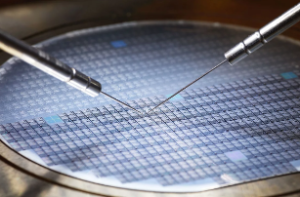Silicon Photonics
 Photonics is the science and technology of generating, controlling, and detecting light. It encompasses a variety of applications, such as transmitting data through optical fibers, using lasers, and employing various imaging techniques.
Photonics is the science and technology of generating, controlling, and detecting light. It encompasses a variety of applications, such as transmitting data through optical fibers, using lasers, and employing various imaging techniques.
Photonics studies how light interacts with matter and its practical applications in communication, medicine, and manufacturing.
What is Silicon Photonics
Silicon photonics combines the capabilities of silicon semiconductor technology with the science of light, known as photonics. It uses silicon on insulator (SOI) wafers as the semiconductor substrate material, and Most conventional CMOS manufacturing procedures are applicable. The goal is to integrate optical components with electronic circuits on a single silicon chip, leveraging the advantages of both technologies. That can lead to faster and more efficient data transmission and processing.
 Why Silicon Photonics
Why Silicon Photonics
The massive data volumes transferred within and between data centers drive an ever-growing demand for higher bandwidth. To meet this need, high-speed communication systems that are also energy-efficient are becoming crucial.
The proliferation of billions of interconnected, intelligent devices and the escalating energy consumption of data centers is driving the need for innovative solutions to improve data transfer speeds and efficiency. Consequently, shifting from electronic to photonic technologies has become a critical technical advancement.
- Meet the rising demand for higher data rates with 5-10 times greater power efficiency than long-range electrical interconnects. Enhance fiber-optic communication networks by improving reliability through reduced signal loss and degradation.
- Utilize high-performance active photonic and low-loss passive components to achieve data rates up to 0.5 Tbps per fiber.
- Employ high-bandwidth, low-power optical interconnects for advanced data center solutions.
- Overcome the limitations of copper cables by delivering up to 8 times the data rate with lower power consumption and heat generation.
- Silicon photonics (SiPh) is being used more in different fields. These include optical data communication, sensing, biomedical applications, automotive technology, astronomy, aerospace, augmented/virtual reality (AR/VR), and artificial intelligence (AI). For example, integrated LiDAR chips for autonomous vehicles illustrate its use in the automotive sector.
Silicon photonics 2016-2025 market forecast  Conclusion
Conclusion
The efficiency of silicon is merging with the speed of light to revolutionize data management. This technology promises to revolutionize data transmission in data centers, telecommunications, and advanced computing, delivering faster speeds and reduced costs. By leveraging the high-speed capabilities of optical signals and integrating them with silicon-based circuits, silicon photonics enables more efficient data processing and transmission. The advancements improve efficiency and reduce energy consumption, creating opportunities for more flexible and cost-effective solutions for handling large amounts of data.
Shortly, silicon photonics is anticipated to grow significantly. The rising need for rapid and efficient data transfer, driven by cloud computing, 5G, and AI, will accelerate its adoption. As data centers expand and demand for high-speed internet increases, silicon photonics will become a critical technology to meet these requirements. Improved technology and manufacturing processes are expected to enhance the value of silicon photonics further. These advancements will likely reduce production costs and widespread implementation, solidifying its role in next-generation communication infrastructure.
As technology evolves, it is expected to reveal new applications, expanding its impact beyond traditional uses.”Silicon photonics is set to revolutionize industries like healthcare, automotive, and defense.” influence various industries, including healthcare, automotive, and defense. For instance, its capabilities could enhance diagnostic tools, enable advanced autonomous vehicle systems, and improve sensor technologies.
Overall, silicon photonics is not just an upgrade but a key player in the future of digital technology. It will be essential in meeting the ever-growing demands for faster and more efficient data transfer.
AUTHOR: ARPIT BHARDWAJ, PATENT RESEARCH ANALYST

 In recent developments, Samsung has filed several Ground-breaking patents showcasing its continued leadership in display technology. These patents emphasize advancements in thin-film transistors and display apparatus but also explore innovative methods in thin-film deposition and organic light-emitting diode (OLED) displays.
In recent developments, Samsung has filed several Ground-breaking patents showcasing its continued leadership in display technology. These patents emphasize advancements in thin-film transistors and display apparatus but also explore innovative methods in thin-film deposition and organic light-emitting diode (OLED) displays. Additive manufacturing, commonly known as 3D, has emerged as a robust and reliable technological alternative to many traditional manufacturing and fabrication methods. However, a new and potentially disruptive advancement is quickly gaining momentum in the backdrop of technology. This development promises to revolutionize industries even more profoundly than 3D manufacturing has done so far.
Additive manufacturing, commonly known as 3D, has emerged as a robust and reliable technological alternative to many traditional manufacturing and fabrication methods. However, a new and potentially disruptive advancement is quickly gaining momentum in the backdrop of technology. This development promises to revolutionize industries even more profoundly than 3D manufacturing has done so far. In the rapidly changing field of artificial intelligence (AI) and self-driving cars, Tesla constantly boundaries with innovative advancements. Recently released filings demonstrate Tesla’s commitment to advancing technology in various areas through patents and applications.
In the rapidly changing field of artificial intelligence (AI) and self-driving cars, Tesla constantly boundaries with innovative advancements. Recently released filings demonstrate Tesla’s commitment to advancing technology in various areas through patents and applications. The use of human experts versus AI-based search tools in intellectual property rights (IPR) is the subject of ongoing debate. While AI has made significant strides in automating search processes and handling vast amounts of data, there are several reasons why manual searches by human professionals remain essential and, in many cases, superior. Here are some reasons why humans are better than AI for IPR searches and why AI still can not replace human jobs in this sector.
The use of human experts versus AI-based search tools in intellectual property rights (IPR) is the subject of ongoing debate. While AI has made significant strides in automating search processes and handling vast amounts of data, there are several reasons why manual searches by human professionals remain essential and, in many cases, superior. Here are some reasons why humans are better than AI for IPR searches and why AI still can not replace human jobs in this sector. Food is essential for life. It is a fundamental requirement for humans, animals, birds, insects, and all other living beings. Everyone needs to eat, but no one wants to produce. This imbalance creates a challenge: the demand for food continues to grow, but the willingness and capacity to generate it need to catch up.
Food is essential for life. It is a fundamental requirement for humans, animals, birds, insects, and all other living beings. Everyone needs to eat, but no one wants to produce. This imbalance creates a challenge: the demand for food continues to grow, but the willingness and capacity to generate it need to catch up.

 Food is a fundamental necessity for all living beings. With the global population projected to increase significantly, the demand for food is expected to rise, potentially leading to future food shortages. Integrating technology into the agriculture sector is crucial to address this impending challenge.
Food is a fundamental necessity for all living beings. With the global population projected to increase significantly, the demand for food is expected to rise, potentially leading to future food shortages. Integrating technology into the agriculture sector is crucial to address this impending challenge.